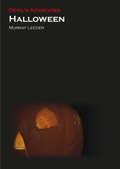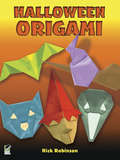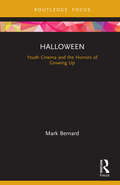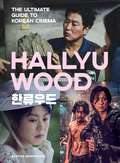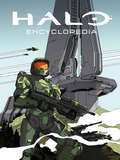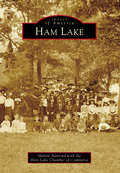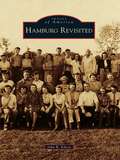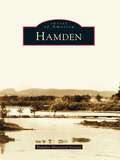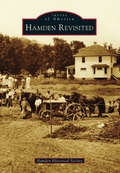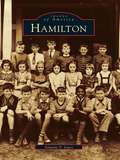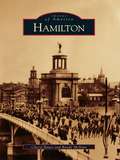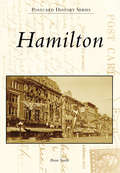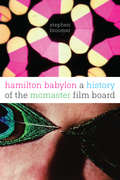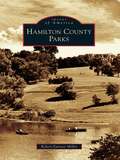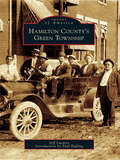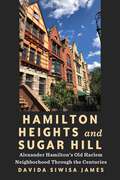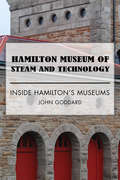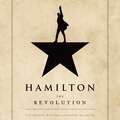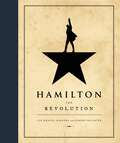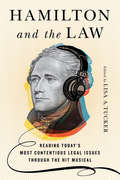- Table View
- List View
Hallmark Channel Countdown to Christmas: Have a Very Merry Movie Holiday
by Caroline McKenzieThe official Hallmark Channel Christmas keepsake takes you behind-the-scenes of your favorite feel-good holiday films with the casts' memories, photos, recipes and more. This stunning book invites readers to an exclusive inside look at the making of everyone's favorite holiday classics with secrets from the stars, screenwriters, set designers, costume designers, and directors who create the movie magic. Featuring the network's top leading ladies and gentlemen--Candace Cameron Bure, Lacey Chabert, Kristin Chenoweth, Debbie Matenopoulos, Cameron Mathison, Chris McNally, Danica McKellar, Christina Milian, Tamera Mowry-Housley, Jodie Sweetin, Holly Robinson Peete, Alexa and Carlos PenaVega, and many others--this ultimate deck-the-halls guide shares their personal holiday recipes, favorite ideas for Christmas decorating and gift giving, as well as ways to savor and share the true meaning of the holidays. Inside you'll find: • 45 recipes for delicious holiday meals, Christmas cookies, desserts, cocktails, and even snacks perfect for serving at your movie marathons, plus recipes from the Hallmark Channel movie stars such as Danica McKellar's Chocolate Yule Log, Chris McNally's Classic Eggnog, and Lacey Chabert's Sweet Potato Pie • A heartfelt foreword from Candace Cameron Bure on her love of the holiday season • An introduction from Country Living Editor-in-Chief Rachel Hardage Barrett on how holiday movies offer comfort and warmth • Super-fun quizzes to test your Hallmark Channel Christmas Movie IQ • Special decorating and gift-wrapping ideas and thoughtful ways to express gratitude • Everything you need to host a watch-party including a play-along bingo card and shareable memes • Color photos throughout including captivating images from your favorite holiday romances • Heartwarming tales of rescue animals like the network's Happy the Dog and Happy the CatIt's the must-have gift for your favorite Hallmark Channel movie fan or for anyone who wants to put a little more happily-ever-after into the happiest season of all!
Halloween (Devil's Advocates)
by Murray LeederThe 1970s represented an unusually productive and innovative period for the horror film, and John Carpenter's Halloween (1978) is the film that capped that golden age – and some say ruined it, by ushering in the era of the slasher film. Considered a paradigm of low-budget ingenuity, its story of a seemingly unremarkable middle-American town becoming the site of violence on October 31 struck a chord within audiences. The film became a surprise hit that gave rise to a lucrative franchise, and it remains a perennial favourite. Much of its success stems from the simple but strong constructions of its three central characters: brainy, introverted teenager Laurie Strode, a late bloomer compared to her more outgoing friends, Dr. Loomis, the driven, obsessive psychiatrist, and Michael Myers, the inexplicable, ghostlike masked killer.Film scholar Murray Leeder offers a bold and provocative study of Carpenter's film, which hopes to expose qualities that are sometime effaced by its sequels and remakes. It explores Halloween as an unexpected ghost film, and examines such subjects as its construction of the teenager, and the relationship of Halloween the film to Halloween the holiday, and Michael Myers's brand of "pure evil." It is a fascinating read for scholars and fans alike.
Halloween Origami
by Nick RobinsonWith its host of haunting creatures, this festive compilation of original models will add spice to any paperfolder's holiday. More than twenty projects, illustrated with photos and two-color diagrams, range from easy to fiendishly challenging. Fold a couple of black cats for your Halloween decorations, and make company for them in the forms of a bat, ghost, and vampire. You'll find witches galore among these figures, as well as a cauldron and a tombstone, fearsome fangs and a grasping hand, and other creepy but fun seasonal motifs.
Halloween: Youth Cinema and the Horrors of Growing Up (Cinema and Youth Cultures)
by Mark BernardThis book argues that Halloween need not be the first nor the most influential youth slasher film for it to hold a special place in the history of youth cinema. John Carpenter’s 1978 horror hit was once considered the be-all, end-all of teen slasher cinema and was regarded as the first, the best, and the most influential American slasher film. Recent revisions in film history, however, have challenged Halloween’s comfortable place in the canon of youth horror cinema. However, this book argues that the film, like no other, draws from the themes, imagery, and obsessions that fueled youth horror cinema since the 1950s—Gothic atmosphere, atomic dread, twisted psychology, and alienated teenage monsters—and ties them together in the deceptively simple story of a masked killer on Halloween night. Along the way, the film delivers a savage critique of social institutions and their failure to protect young people. Halloween also depicts a cadre of compelling and complicated youth characters: teenage babysitters watching over preadolescents as a killer, who is viciously avoiding the responsibilities of young adulthood, stalks them through the shadows. This book explores all these aspects of Halloween, including the franchise it spawned, providing an invaluable insight into this iconic film for students and researchers alike.
Hallyuwood: The Ultimate Guide to Korean Cinema
by Bastian MeiresonneRide the Korean wave (Hallyu) of cinema and explore the most exciting and captivating films in the world today. From smash hits like Parasite to cult favorites Oldboy, The Handmaiden, and Train to Busan, Korean cinema has revolutionized the film industry. Hallyuwood is a comprehensive, cultural dive into Korean cinema from 1900 to the present highlighting more than 100 major films from Golden Age classics to intriguing indies. Asian film expert and writer Bastian Meiresonne explores how Korean cinema found its roots and the cultural, historical, and political forces that have shaped the industry over the last 125 years. With vibrant film stills and original movies posters throughout, Hallyuwood is a celebration of the past, present, and future of Korean cinema and a gateway to everything you need to know about these unique and thrilling movies.
Halo Encyclopedia
by MicrosoftIn the 26th century, humanity relentlessly continues their fight for survival, an enduring conflict set against the backdrop of the enigmatic and ancient ringworld known as Halo. The universe of Halo is remarkably vast in scale and astonishingly elaborate in detail, telling rich stories filled with bold characters, breathtaking worlds, and thrilling conflicts. In celebration of the 20th anniversary of Halo, Dark Horse and 343 Industries have teamed up to deliver the most definitive guide to the universe thus far. Spanning over a hundred millennia and encompassing over a hundred thousand light years, the Halo Encyclopedia captures two decades of storytelling with stunning, never-before-seen art and the most detailed exploration of the universe&’s many characters, worlds, and technologies to have ever been created
Halo: The Official Cookbook (Gaming)
by Victoria RosenthalTravel through the otherworldly culinary adventures of the Halo universe!They say an army marches on its stomach, and the UNSC is no exception! Learn to make awesome appetizers, sumptuous snacks, decadent desserts, and main dishes to fuel even the hungriest of Spartans on the longest of missions. With step-by-step instructions and beautiful photography, this book gives you everything you need to go from Master Chief to Master Chef. OVER 70 RECIPES FOR EVERY OCCASION: From portable snacks you can take with you in the Warthog to decadent spreads to feed the entire squadron, this book contains recipes to satisfy every UNSC member and beyond! PERFECT FOR COOKS OF EVERY SKILL LEVEL: With step-by step directions and beautiful photos, learn to make foods inspired by the iconic Halo universe—whether you&’re an experienced cook or a raw recruit, this book gives you the intel you need to complete your culinary mission. INSPIRING PHOTOGRAPHY: Gorgeous photos of finished recipes help ensure success. A STUNNING ADDITION TO YOUR COLLECTION: This exquisitely detailed hardcover book is the perfect acquisition for your kitchen library—a must have for every Halo fan.
Ham Lake
by Ham Lake Chamber of Commerce Melvin AanerudHam Lake is a six-mile-by-six-mile township as prescribed in the Northwest Territories Act of 1787. One of the area's major lakes looks exactly like a slice of ham, with an island as the ham bone, thus the name. In 1856, a town named Glen Carey, Scottish for "Beautiful Valley," was formed southwest of the lake. Seven or eight homes were built, but a prairie fire burned them out. In 1866, Mads Gilbertson, a native of Norway, was the first permanent settler; other Scandinavians followed. Early settlers found the soil well suited for farming and developed churches, schools, and commercial centers. Farmers raised pigs, turkeys, cattle, and horses, along with corn, wheat, potatoes, and other vegetables and fruit. Ham Lake became the sod-producing capital of Minnesota. Eventually, the town subdivided those farms and grew housing developments--the most profitable crop yet.
Hamburg Revisited
by John R. EdsonHamburg Revisited chronicles the people who led Hamburg in business, education, religion, and civic events during the town's period of growth in the first half of the 20th century. Led by architects Lawrence Bley and Frank Spangenberg, Hamburg developed its distinctive brick and stone architecture of the 1920s and later boomed with growth in the post-World War II period. Many aerial photographs from 1950 show the growth of housing developments in Hamburg village, Blasdell, and Lake Shore, as well as many landmarks that have been lost in the past 50 years.
Hamden
by Hamden Historical SocietyHamden is nicknamed "the Land of the Sleeping Giant" after the series of hills within its bounds that resemble a recumbent giant. But Hamden is much more than the resting place of the legendary "Hobbomock." The town's history is illustrated here in Hamden, which contains photographs dating from the 1840s through the late 1900s. These vintage images depict the contours of community life in Hamden. The collection highlights famous residents, including Eli Whitney and Thornton Wilder; local eccentrics, including the wandering Leatherman and William Beamish, a female printer who lived as a man; changes in the land from forest to farmland to suburbia; businesses, institutions, civic organizations, and churches; and people at play-from skaters on Lake Whitney to hikers on the Sleeping Giant.
Hamden Revisited
by Hamden Historical SocietyAt the turn of the 20th century, the town of Hamden, Connecticut, "the Land of the Sleeping Giant," was a patchwork of small hamlets, largely rural and agricultural. During the next 100 years, it would undergo a dramatic transformation; as orchards and fields gave way to factories and subdivisions, Hamden's population grew from only a few thousand at the beginning of the century to over 60,000. In the time of war needs, local industries like the Web Shop factory and High Standard Manufacturing retooled to meet demands. The middle of the century saw the appearance of some of the first shopping malls in the state, including Hamden Plaza. Major universities attracted workers, families, intellects, and authors. Hamden was the childhood home of poet laureate Donald Hall, the residence of playwright Thornton Wilder, and the birthplace of Ernest Borgnine. As the town's diversity grew, the community faced the challenges and opportunities of each generation and, inevitably, its identity evolved.
Hamilton
by Annette V. JanesTwo hundred years ago, the people of Hamilton harnessed the power of the Ipswich River to operate their mills and relied on Chebacco Lake for food and trade. Originally part of the town of Ipswich, Hamilton became a town in 1793. Many years later, it was a fashionable summer retreat for wealthy Bostonians. Hamilton takes the reader on a journey through time to see how life was in a small rural town, located between Salem and Ipswich. Within these pages, see the summer home of Gen. George S. Patton, a World War II hero of mythic proportion; the resting place of a sagamore with a macabre history; and the home of Manassah Cutler, a Congregational minister and an agent of the Ohio company that helped to open up the Northwest Territory. In Hamilton, take a tour of a unique religious camping ground; learn about the Myopia Hunt Club, which occasionally still rides to hounds; and see an ancient Native American trail turned highway.
Hamilton
by Randy Mcnutt Cheryl BauerFounded as Fort Hamilton in 1791, the City of Hamilton was settled by pioneers and immigrants and was forged in steel by her talented workers and craftsmen. Factory owners became wealthy and built magnificent homes along Dayton Street. Hamilton prospered and became known as the "Greatest Little Industrial City of Its Kind in the World," home to Mosler Safe Co., Ford Motor Co., Beckett Papers, and many others. Following World War II, some factories closed their doors or moved away, but Hamilton persevered and became a city powered by small business and the arts. Through vintage images, this book showcases Hamilton's success, its survival of the Flood of 1913, its blue-collar job loss, and now, its rise as the "City of Sculpture," attracting sculptors from across the world.
Hamilton (Postcard History)
by Brian SmithThough not incorporated as a city until 1857, Hamilton can trace its roots back to the founding of Fort Hamilton by Gen. Arthur St. Clair in 1791.Throughout its history, Hamilton has been "The Greatest Little City of its Kind in the World," "The Postmark of Distinctive Trademarks," and "Known in the World's Markets." In the time between the close of the Civil War and the beginning of World War II, the city thrived. Led by steadfast pioneers and industrious immigrants, Hamilton developed into a community where anything seemed possible along the banks of the Great Miami River. The images herein detail Hamilton from 1900 to the 1950s. From a bustling county seat and the hub of Midwestern industry to leisurely endeavors, from distinctive neighborhoods to the people who lived in them, and from local education to individual worship, the life of the city is captured by over 200 postcards of the day, most from the author's private collection.
Hamilton Babylon
by Stephen BroomerFounded in 1966 at McMaster University by avant-garde filmmaker John Hofsess and future frat-comedy innovator Ivan Reitman, the McMaster Film Board was a milestone in the development of Canada's commercial and experimental film communities. McMaster's student film society quickly became the site of art filmmaking and an incubator for some of the country's most famous commercial talent - as the well as the birthplace of the first Canadian film to lead to obscenity charges, Hofsess's Columbus of Sex.In Hamilton Babylon, Stephen Broomer traces the history of the MFB from its birth as an organization for producing and exhibiting avant-garde films, through its transformation into a commercial-industrial enterprise, and into its final decline as a show business management style suppressed many of its voices. The first book to highlight the work of Hofsess, an innovative filmmaker whose critical role in the MFB has been almost entirely eclipsed by Reitman's legend, Hamilton Babylon is a fascinating study of the tension between art and business in the growth of the Canadian film industry.
Hamilton County Parks
by Robert Earnest MillerHamilton County parks have long been popular destinations for a variety of outdoor activities such as hiking, fishing, golf, and boating. At the same time, the parks have worked diligently to preserve wetlands, prairies, and other natural habitats. Hamilton County Parks explores a fascinating and little explored chapter of Hamilton County history. It spans more than 75 years of local history, tracing the development of the park system and the services it has provided its residents over the years. Join author Robert Earnest Miller as he tells the story of the Hamilton County parks through photographs and other visual materials from an extensive collection maintained by the staff of the Hamilton County Park District. The vast majority of these images have never been published or displayed for the public before.
Hamilton County's Green Township (Images of America)
by Paul Ruffing Jeff LuedersThe Green Township communities of Bridgetown, Covedale, Dent, Mack, Monfort Heights, and White Oak had their humble beginnings in 1809. By the early 1900s, Green Township was primarily a rural farming community. The advent of the streetcar, and eventually the automobile, made traveling much easier. New and improved roads and better cars in the 1930s and 1940s enabled workers to commute to Cincinnati or the industrial Millcreek Valley. With this growth, the west side expanded greatly with the building of new homes, schools, and churches. By 1940, there were 18,500 Green Township residents. By 1960, the number had grown to more than 37,300. The 2000 census listed 55,660 residents, making Green Township the second-largest township in Ohio.
Hamilton Heights and Sugar Hill: Alexander Hamilton’s Old Harlem Neighborhood Through the Centuries
by Davida Siwisa JamesExplores four centuries of colonization, land divisions, and urban development around this historic landmark neighborhood in West HarlemIt was the neighborhood where Alexander Hamilton built his country home, George Gershwin wrote his first hit, a young Norman Rockwell discovered he liked to draw, and Ralph Ellison wrote Invisible Man. Through words and pictures, Hamilton Heights and Sugar Hill traces the transition of this picturesque section of Harlem from lush farmland in the early 1600s to its modern-day growth as a unique Manhattan neighborhood highlighted by stunning architecture, Harlem Renaissance gatherings, and the famous residents who called it home. Stretching from approximately 135th Street and Edgecombe Avenue to around 165th, all the way to the Hudson River, this small section in the Heights of West Harlem is home to so many significant events, so many extraordinary people, and so much of New York’s most stunning architecture, it’s hard to believe one place could contain all that majesty. Author Davida Siwisa James brings to compelling literary life the unique residents and dwelling places of this Harlem neighborhood that stands at the heart of the country’s founding. Here she uncovers the long-lost history of the transitions to Hamilton Grange in the aftermath of Alexander Hamilton’s death and the building boom from about 1885 to 1930 that made it one of Manhattan’s most historic and architecturally desirable neighborhoods, now and a century ago. The book also shares the story of the LaGuardia High School of Music & Art, one of the fi rst in the nation to focus on arts and music. The author chronicles the history of the James A. Bailey House, as well as the Morris-Jumel Mansion, Manhattan’s oldest surviving residence and famously known as George Washington’s headquarters at the start of the American Revolution. By telling the history of its vibrant people and the beautiful architecture of this lovely, well-maintained historic landmark neighborhood, James also dispels the misconception that Harlem was primarily a ghetto wasteland. The book also touches upon the Great Migration of Blacks leaving the South who landed in Harlem, helping it become the mecca for African Americans, including such Harlem Renaissance artists and luminaries as Thurgood Marshall, Count Basie, Duke Ellington, Mary Lou Williams, Paul Robeson, Regina Anderson Andrews, and W. E. B. Du Bois.
Hamilton Museum of Steam and Technology: Inside Hamilton's Museums
by John GoddardInside Hamilton’s Museums helps to satisfy a growing curiosity about Canada’s steel capital as it evolves into a post-industrial city and cultural destination. In this special excerpt we visit Hamilton Museum of Steam and Technology, which displays the wondrous twin waterworks engines that supplied the City of Hamilton with fresh, safe drinking water. John Goddard takes us on a detailed tour of the dignified limestone building, providing fascinating historical background and insight into the waterworks.
Hamilton's Industrial Heritage
by Richard N. PilandHamilton has been an important activity center in Butler County since its founding in 1791, as its proximity to the Great Miami River made it an ideal county seat and agricultural hub. Beginning in 1845, the Hamilton Hydraulic Company diverted the river's flow through town and developed a system that supplied cheap waterpower to area mills. By 1900, Hamilton was "the greatest manufacturing city of its size in the world," and by the 1940s it was home to several of the world's largest industries. Champion Paper milled coated paper, Niles Tool Works manufactured machine tools, Hooven-Owens-Rentschler built Corliss engines, Estate Stove made stoves, and Mosler and Herring-Hall-Marvin Safe Companies earned Hamilton its reputation as the "Safe Capital of the World." More than 150 factories and shops developed diverse product lists in the early 1900s, but only three of these businesses still operate in Hamilton today.
Hamilton: The Revolution
by Lin-Manuel Miranda Jeremy McCarterWinner of the 2016 Pulitzer Prize for DramaNow a major motion picture, available on Disney Plus.Goodreads best non-fiction book of 2016From Tony Award-winning composer-lyricist-star Lin-Manuel Miranda comes a backstage pass to his groundbreaking, hit musical Hamilton.Lin-Manuel Miranda's groundbreaking musical Hamilton is as revolutionary as its subject, the poor kid from the Caribbean who fought the British, defended the Constitution, and helped to found the United States. Fusing hip-hop, pop, R&B, and the best traditions of theater, this once-in-a-generation show broadens the sound of Broadway, reveals the storytelling power of rap, and claims the origins of the United States for a diverse new generation.HAMILTON: THE REVOLUTION gives readers an unprecedented view of both revolutions, from the only two writers able to provide it. Miranda, along with Jeremy McCarter, a cultural critic and theater artist who was involved in the project from its earliest stages - "since before this was even a show," according to Miranda - traces its development from an improbable performance at the White House to its landmark opening night on Broadway six years later. In addition, Miranda has written more than 200 funny, revealing footnotes for his award-winning libretto, the full text of which is published here.Their account features photos by the renowned Frank Ockenfels and veteran Broadway photographer, Joan Marcus; exclusive looks at notebooks and emails; interviews with Questlove, Stephen Sondheim, leading political commentators, and more than 50 people involved with the production; and multiple appearances by President Obama himself. The book does more than tell the surprising story of how a Broadway musical became an international phenomenon: It demonstrates that America has always been renewed by the brash upstarts and brilliant outsiders, the men and women who don't throw away their shot.
Hamilton: The Revolution
by Lin-Manuel Miranda Jeremy McCarterWinner of the 2016 Pulitzer Prize for DramaNow a major motion picture, available on Disney Plus.Goodreads best non-fiction book of 2016From Tony Award-winning composer-lyricist-star Lin-Manuel Miranda comes a backstage pass to his groundbreaking, hit musical Hamilton.Lin-Manuel Miranda's groundbreaking musical Hamilton is as revolutionary as its subject, the poor kid from the Caribbean who fought the British, defended the Constitution, and helped to found the United States. Fusing hip-hop, pop, R&B, and the best traditions of theater, this once-in-a-generation show broadens the sound of Broadway, reveals the storytelling power of rap, and claims the origins of the United States for a diverse new generation.HAMILTON: THE REVOLUTION gives readers an unprecedented view of both revolutions, from the only two writers able to provide it. Miranda, along with Jeremy McCarter, a cultural critic and theater artist who was involved in the project from its earliest stages - "since before this was even a show," according to Miranda - traces its development from an improbable performance at the White House to its landmark opening night on Broadway six years later. In addition, Miranda has written more than 200 funny, revealing footnotes for his award-winning libretto, the full text of which is published here.Their account features photos by the renowned Frank Ockenfels and veteran Broadway photographer, Joan Marcus; exclusive looks at notebooks and emails; interviews with Questlove, Stephen Sondheim, leading political commentators, and more than 50 people involved with the production; and multiple appearances by President Obama himself. The book does more than tell the surprising story of how a Broadway musical became an international phenomenon: It demonstrates that America has always been renewed by the brash upstarts and brilliant outsiders, the men and women who don't throw away their shot.
Hamilton: The Revolution
by Lin-Manuel Miranda Jeremy MccarterWinner of the 2016 Pulitzer Prize for Drama<P><P>Lin-Manuel Miranda's groundbreaking musical Hamilton is as revolutionary as its subject, the poor kid from the Caribbean who fought the British, defended the Constitution, and helped to found the United States. Fusing hip-hop, pop, R&B, and the best traditions of theater, this once-in-a-generation show broadens the sound of Broadway, reveals the storytelling power of rap, and claims our country's origins for a diverse new generation. HAMILTON: THE REVOLUTION gives readers an unprecedented view of both revolutions, from the only two writers able to provide it. Miranda, along with Jeremy McCarter, a cultural critic and theater artist who was involved in the project from its earliest stages--"since before this was even a show," according to Miranda--traces its development from an improbable performance at the White House to its landmark opening night on Broadway six years later. In addition, Miranda has written more than 200 funny, revealing footnotes for his award-winning libretto, the full text of which is published here. Their account features photos by the renowned Frank Ockenfels and veteran Broadway photographer, Joan Marcus; exclusive looks at notebooks and emails; interviews with Questlove, Stephen Sondheim, leading political commentators, and more than 50 people involved with the production; and multiple appearances by President Obama himself. The book does more than tell the surprising story of how a Broadway musical became a national phenomenon: It demonstrates that America has always been renewed by the brash upstarts and brilliant outsiders, the men and women who don't throw away their shot.<P> Advisory: Bookshare has learned that this book offers only partial accessibility. We have kept it in the collection because it is useful for some of our members. To explore further access options with us, please contact us through the Book Quality link on the right sidebar. Benetech is actively working on projects to improve accessibility issues such as these. <P><b>A New York Times Bestseller</b>
Hamilton and the Law: Reading Today's Most Contentious Legal Issues through the Hit Musical
Since its Broadway debut, Hamilton: An American Musical has infused itself into the American experience: who shapes it, who owns it, who can rap it best. Lawyers and legal scholars, recognizing the way the musical speaks to some of our most complicated constitutional issues, have embraced Alexander Hamilton as the trendiest historical face in American civics. Hamilton and the Law offers a revealing look into the legal community's response to the musical, which continues to resonate in a country still deeply divided about the reach of the law. A star-powered cast of legal minds—from two former U.S. solicitors general to leading commentators on culture and society—contribute brief and engaging magazine-style articles to this lively book. Intellectual property scholars share their thoughts on Hamilton's inventive use of other sources, while family law scholars explore domestic violence. Critical race experts consider how Hamilton furthers our understanding of law and race, while authorities on the Second Amendment discuss the language of the Constitution's most contested passage. Legal scholars moonlighting as musicians discuss how the musical lifts history and law out of dusty archives and onto the public stage. This collection of minds, inspired by the phenomenon of the musical and the Constitutional Convention of 1787, urges us to heed Lin-Manuel Miranda and the Founding Fathers and to create something new, daring, and different.
Hamlet after Deconstruction (Adaptation in Theatre and Performance)
by Aneta MancewiczPost-war European adaptations of Hamlet are defined by ambiguities and inconsistencies. Such features are at odds with the traditional model of adaptation, which focuses on expanding and explaining the source. Inspired by Derrida’s deconstruction, this book introduces a new interpretative paradigm. Central to this paradigm is the idea that an act of adaptation consists in foregrounding gaps and incoherencies in the source; it is about questioning rather than clarifying. The book explores this paradigm through seven representative European adaptations of Hamlet produced between the 1960s and the 2010s: dramatic texts, live theatre productions, and a mixed reality performance. They systematically challenge the post-Romantic idea of Hamlet as a tragedy of great passions and heroic deeds. What does this say about Hamlet’s impact on post-war theatre and culture? The deconstructive analyses offered in this book show how adaptations of Hamlet capture crucial anxieties and concerns of post-war Europe, such as political disillusionment, postmodern scepticism, and feminist resistance, revealing exciting connections between European traditions.

